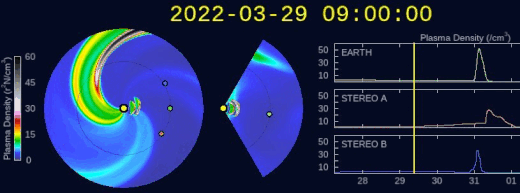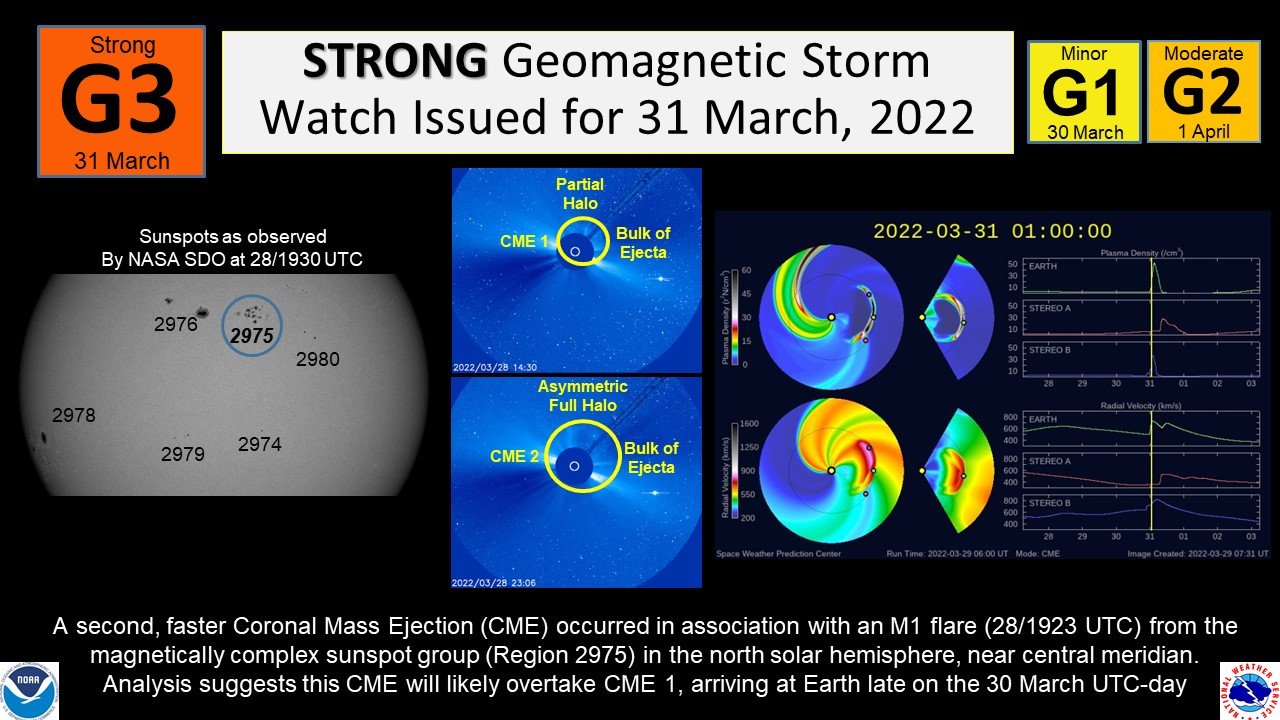10:00 AM | *”Merged” coronal mass ejection to strike Earth’s magnetic field on Thursday, March 31st…strong G-3 class geomagnetic storm possible*
Paul Dorian
Sunspot AR2975 erupted on March 28th (1129 UTC), producing a major M4-class solar flare. The blast propelled a 'solar tsunami' through the sun's atmosphere. You can see it rippling away from the blast site in this movie from the Solar Dynamics Observatory. Courtesy NASA, NOAA, spaceweather.com
Overview
Solar cycle 25 is well underway now and it has become increasingly active with more numerous sunspots in recent months as we grind our way towards the next solar maximum. In fact, there have been no days this year without sunspots which is down from 64 days in 2021, 208 in 2020, and 281 in 2019 which was the time of the last solar minimum. One sunspot known officially as AR2975 unleashed a frenzy of solar flares a couple of days and at least two full coronal mass ejections (CMEs) emerged from the action. A single “merged” CME is expected to hit the Earth’s magnetic field in the early hours of Thursday, March 31st, perhaps as a strong G-3 class geomagnetic storm.
A NOAA computer model suggests that the second CME will overtake the first, merging into a single "Cannibal CME" before striking Earth's magnetic field around 0300 UTC on March 31st. Courtesy NASA, NOAA, spaceweather.com
Details
Solar cycle 25 began in late 2019 and is expected to reach a maximum sometime during 2025. As we climb towards the next solar maximum, more and more sunspots have been appearing and there has been all kinds of activity in just the last few days. On Monday, March 28th, sunspot AR2975 moved to a position facing the Earth and it produced as many as 17 solar flares – 11 C-class (small) and 6-M-class (medium).
Sunspot AR2975 was facing the Earth when it unleashed multiple solar flares on Monday, March 28th. This 3-day loop of the sun shows the movement AR2975 and other sunspots since Monday until today. Images courtesy NASA/SDO, spaceweather.com
At least two coronal mass ejections (CMEs) emerged from this activity and the second one is actually expected to overtake the first one as it is traveling at a higher speed. Specifically, the first CME was produced by an M4-class flare traveling at 1259 km/s according to spaceweather.com while the second one – an M1-class flare – was traveling at 1700 km/s. This “merged” CME – being dubbed the “cannibal” - is expected to strike the Earth’s magnetic field around 0300 UT on Thursday, March 31st. If the NOAA models are correct, the density of the solar wind plasma around Earth could increase 10-fold when the CME arrives setting the stage for a G3 (strong) class geomagnetic storm. There is even a chance that this storm reaches G4 (severe) levels in its classification.
Summary information of the incoming CME courtesy NOAA, NASA.
In terms of ramifications, one of the possibilities is for auroras to develop late tonight/early Thursday and again later tomorrow night as far south as the northern US. Impacts to technology from a G3 storm generally remain small, but this will be monitored closely not only on Thursday, but also on Friday, April 1st.
Meteorologist Paul Dorian
Arcfield
arcfieldweather.com
Follow us on Facebook, Twitter, YouTube
Video discussion:




